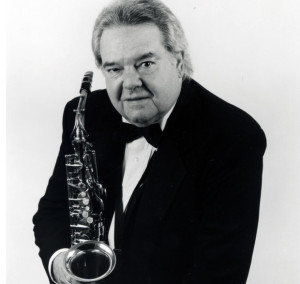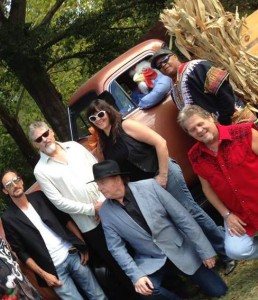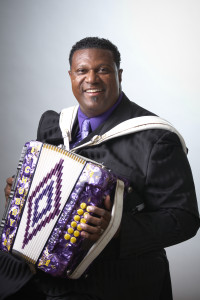GLEN DAVID ANDREWS
- By lrhr-admin
- In ARTISTS LEGACY
- With No Comments
- Tagged with Glen David Andrews Treme
- On 23 Feb | '2012
A warrior for cultural preservation in New Orleans at a time when indigenous traditions are being threatened, Andrews is standing up now for his own salvation. As the journalist Larry Blumenfeld, a Katrina Media Fellow with the Open Society Institute, has written: ”Long before he began trying to save himself in earnest, Andews’s music projected the promise of redemption…His remarkable singing voice and commanding trombone sound (both powerful, direct, resonant, and with just enough rasp) as well as his disarmingly honest manner have provided whatever the situation calls for: beauty, truth, compassion, anger, joy or all of the above.”
Andrews comes from a storied extended family of musicians. He was born in the historic Tremé neighborhood – which many consider to be the oldest black community in the United States – where the struggle to survive is older than the mighty oak trees in the Crescent City. According to family folklore, Anthony “Tuba Fats” Lacen, a patriarch of modern New Orleans music, directed the bell of his horn toward Andrews’s mother’s belly as a way to induce labor. Andrews was born the following day. Transfixed by the magic and mystery of the city’s second-line parades, Andrews and his older brother, Derrick Tabb of the Rebirth Brass Band, along with their younger cousin Troy “Trombone Shorty,” soaked up life’s musical lessons by learning the history of the brass band tradition firsthand from iconic figures like Tuba Fats. They also learned the power of the city’s Mardi Gras Indian culture.
“The musicians I heard coming up literally brought me out of the womb,” Andrews says. “Jesus was born in a manger. I was born in a second line.”
Starting on the bass drum as a child, Andrews soon picked up the trombone; he was blowing a joyful noise by the time he was 12. He practiced his musicianship and showmanship with the city’s most energetic brass bands, from New Birth and L’il Rascals to ReBirth and Treme. “He’s always had a massive presence and a massive sweetness,” says Paul Sanchez, the New Orleans singer-songwriter who has collaborated with Andrews.
That presence and sweetness have long endeared Andrews to audiences at his regular gigs at such New Orleans clubs as dba and Three Muses. In recent years he began making waves as a headliner at the world’s biggest block party – the annual New Orleans Jazz & Heritage Festival where he has ripped it up in the gospel tent, the blues tent and the jazz tent. “ “Glen is one of the giant talents of New Orleans music,” says the festival’s producer Quint Davis.
Andrews says he’s determined to make new fans with Redemption. Leo Sacks, who produced the project, says that ”Glen surprised everyone with the emotional range and maturity of his voice. It was astonishing to hear him slide from a whisper to a scream.” A dear friend of New Orleans music who produced the New Orleans Social Club’s Sing Me Back Home after Katrina and won a 2014 Grammy Award for documenting the life’s work of Bill Withers, Sacks says that Andrews conjured “the soul fire of Wilson Pickett, the preacher power of Solomon Burke and the world-weariness of Louis Armstrong’s voice. He took artistic risks that were tremendously courageous.”
The centerpiece of the new album is “Surrender,” a deeply personal song about acceptance which Andrews wrote in rehab. “I woke up from a nightmare, in a cold sweat,” he recalls in chilling detail. “That nightmare was my life. I realized I had been given an opportunity to change my attitudes, my actions, my whole outlook on living. I knew it was okay to forgive myself. That was my moment of grace.”
With the release of Redemption, Louisiana Red Hot Records is also making available four of Andrews’s previous projects: the gospel-driven Walking Through Heaven’s Gate (recorded live in 2009 at Zion Hill Baptist Church in New Orleans where Andrews was baptized); Live at Three Muses, a sweaty club date from 2012; and two trad jazz releases, French Quarter Jazz from Jackson Square (his first recording, from 1997) and Dumaine Street Blues (2002).
PRESS
“Andrews and his band are a force. Their music is an electrifying combination of Funk, R&B, Jazz, Gospel and Zydeco, a joyful, communal noise that prompts, even the most casual listeners to lose their inhibitions, whoop, holler and shake the booty. (San Jose Jazz Festival, Aug 8, 2015)” – Latin Jazz Net
“Redemption, New Orleans trombonist/vocalist Glen David Andrews’s electrifying, career (re-)defining opus, is all about metaphoric rebirth, linking his own spiritual and physical rehab with the Crescent City’s post-Katrina recovery. The music is a fiery amalgam of brass band roots, gospel, funk, soul, and R&B. And it rocks with all the gritty, soulful, ass-shakin’ intensity Andrews can muster, which pretty much sets the standard these days.” – Rick Mason, Minneapolis City Pages
“A mix of preacher, R&B singer, jazz vocalist, trombonist and New Orleans musical history lesson, Glen David Andrews is a sweaty showman, entertainer and improviser. He has a Louis Armstrong rasp, an Al Green falsetto, a Thomas Dorsey sense of spirituals, James Brown moves with the microphone stand, trombone licks a la Trombone Shorty (his cousin) and Robin Williams-like manic energy. Look for Andrews to showcase material from this year’s commendable ‘Redemption’, whose highlights include the funky ‘Bad by Myself’ and the breezy, gospelly ‘Movin’ Up’.” – Minneapolis Star
“Andrews has talent to spare. He is an amazing player and singer. The trombonist/vocalist’s legendary performances (melding rock, pop, soul, gospel, jazz, funk and brass) are nothing less than electrifying…. On what was the warmest day of the year (to that point) in New York City, Andrews and his band burned through a blistering set at the Rockwood Music Hall. If it was hot outside the venue, it was even hotter inside. The walls were sweating, the floor was bouncing. The audience members were singing along and jumping up and down while Andrews, their leader, functioned as master of ceremonies at what was part rock ‘n’ funk concert, part gospel revival service, part Mardi Gras party and one helluva good time.” – Mike Perciaccante, All About Jazz
“True redemption is earned: a celebration of today, anchored by lessons learned through the work it took to get here and sweetened with gratitude for our good fortune. This record is steeped in all that, soaked in tears and night sweats that have been dried but not forgotten. It’s revealed by degrees — first in the thunderclap opening of “NY to Nola,” then with cuts like the funky, rueful “Bad by Myself,” Andrews’ Mahalia Jackson-assisted cover of “Didn’t It Rain,” and the downright lovely “Surrender,” as well as a trio of post-rehab anthems (‘Movin’ Up’, ‘Lower Power’, and ‘You Don’t Know’), the latter two of which feature appearances from fellow survivor Anders Osborne. The whole journey culminates with a beautiful rendition of the Curtis Mayfield classic ‘Something to Believe In’ that sends the record sailing out on a note of well-deserved rest and release.” – Jeff Giles, popdose
“A stunning achievement… a career-best triumph for both artist and producer, an album that joins recent work by Trombone Shorty and Rebirth Brass Band in a new era of New Orleans jazz and R&B excellence.” – John Swenson, Offbeat Magazine







